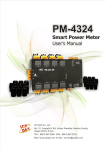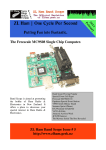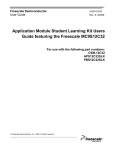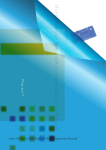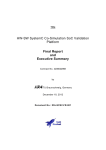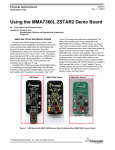Download DEMO9S08QG8UG, Application Module Student Learning Kit
Transcript
Freescale Semiconductor User Guide DEMO9S08QG8UG Rev. 0, 12/2006 Application Module Student Learning Kit Users Guide featuring the Freescale MC9S08QG8 For use with the following part numbers: APS08QG8SLK PBS08QG8SLK CSM9S08QG8SLK DEMO9S08QG8SLK © Freescale Semiconductor, Inc., 2006. All rights reserved. _______________________________________________________________________ CONTENTS CAUTIONARY NOTES ...........................................................................................................................4 TERMINOLOGY ......................................................................................................................................4 FEATURES ................................................................................................................................................5 REFERENCES...........................................................................................................................................6 INTRODUCTION......................................................................................................................................7 GETTING STARTED ...............................................................................................................................7 POWER .................................................................................................................................................. 7 POWER SELECT............................................................................................................................... 8 PWR_SEL........................................................................................................................................... 8 VX_EN ............................................................................................................................................... 8 RESET SWITCH ................................................................................................................................... 9 LOW VOLTAGE DETECT................................................................................................................... 9 STOP MODES ....................................................................................................................................... 9 TIMING.................................................................................................................................................. 9 COMMUNICATIONS......................................................................................................................... 10 SCI PORT ........................................................................................................................................ 10 COM_EN ......................................................................................................................................... 10 COM CONNECTOR ........................................................................................................................ 11 SPI PORT......................................................................................................................................... 12 IIC PORT ......................................................................................................................................... 12 USER OPTIONS.................................................................................................................................. 12 PUSHBUTTON SWITCHES ............................................................................................................ 12 LED INDICATORS .......................................................................................................................... 12 POTENTIOMETER ......................................................................................................................... 12 PHOTOCELL................................................................................................................................... 12 I/O PORT CONNECTOR .................................................................................................................... 13 OPERATING MODES ........................................................................................................................ 14 RUN MODE..................................................................................................................................... 14 DEBUG MODE ............................................................................................................................... 14 DEVELOPMENT SUPPORT ................................................................................................................16 SOFTWARE DEVELOPMENT.......................................................................................................... 16 MEMORY MAP................................................................................................................................ 16 INTEGRATED BDM_PORT .............................................................................................................. 16 BDM_PORT HEADER ....................................................................................................................... 17 2 Freescale Semiconductor FIGURES Figure 1: PWR_SEL Option Header ......................................................................................................8 Figure 2. VX_EN Option Header ...........................................................................................................9 Figure 3: OSC_EN Option Header .......................................................................................................10 Figure 4: COM Connector......................................................................................................................11 Figure 5: MCU I/O Port Connector .......................................................................................................13 Figure 6: BDM Port .................................................................................................................................17 TABLES Table 1: COM_EN Option Header........................................................................................................11 Table 2: User Option Jumper Settings.................................................................................................13 Table 3: Run Mode Setup ......................................................................................................................14 Table 4: Debug Mode Setup .................................................................................................................15 Table 5: Memory Map.............................................................................................................................16 REVISION Date December 14, 2005 Freescale Semiconductor Rev 0 Comments Initial Release. 3 CAUTIONARY NOTES ♦ Electrostatic Discharge (ESD) prevention measures should be used when handling this product. ESD damage is not a warranty repair item. ♦ Axiom Manufacturing does not assume any liability arising out of the application or use of any product or circuit described herein; neither does it convey any license under patent rights or the rights of others. ♦ EMC Information on the APS08QG8SLK board: a) This product, as shipped from the factory with associated power supplies and cables, has been verified to meet with FCC requirements as a CLASS A product. b) This product is designed and intended for use as a development platform for hardware or software in an educational or professional laboratory. c) In a domestic environment, this product may cause radio interference in which case the user may be required to take adequate prevention measures. d) Attaching additional wiring to this product or modifying the product operation from the factory configuration may affect its performance and cause interference with other apparatus in the immediate vicinity. If such interference is detected, suitable mitigating measures should be taken. TERMINOLOGY This development board uses option selection jumpers. A jumper is a plastic shunt that connects 2 terminals electrically. Terminology for application of the option jumpers is as follows: Jumper – a plastic shunt that connects 2 terminals electrically Jumper on, in, or installed - jumper is installed such that 2 pins are connected together Jumper off, out, or idle - jumper is installed on 1 pin only. It is recommended that jumpers be idled by installing on 1 pin so they will not be lost. Cut-Trace – a circuit trace connection between component pads. The circuit trace may be cut using a razor knife to break the default connection. To reconnect the circuit, simply install a suitably sized 0-ohm resistor or attach a wire across the pads. Throughout this document, where used, the name APS08QG8SLK applies equally to the APS08QG8SLK, CSM9S08QG8SLK, and PBS08QG8SLK. 4 Freescale Semiconductor FEATURES The APS08QG8SLK is an educational application module for the Freescale Semiconductor MC9S08QG8 microcontroller. Development of applications is quick and easy with the integrated USB-BDM, sample software tools, and examples. An optional BDM_PORT port is also provided to allow use of a BDM_PORT cable. A 32-pin connector allows connecting the APS08QG8SLK board to an expanded evaluation environment. • • • • • • • • • • MC9S08QG8 CPU, 16-pin DIP, Socketed • 8K Byte Flash • 512 Bytes RAM • Internal 32 kHz Oscillator, trimmable to ±0.2% • 12 GPIO, 1 Input Only, 1 Output only • Timer Interface Module • SCI and SPI Communication Ports • IIC Module • 8 KBI inputs • 2-Ch, 16-bit, Timer Interface • 8-Ch, 10-bit Analog to Digital Converter (ATD) • Analog Comparator w/ internal compare Integrated USB-BDM RS-232 Serial Port w/ DB9 Connector SPI, IIC ports available on Connector J1 External 32.768 kHz Clock Oscillator (not installed) Power Input Selection Jumper • Power input from USB-BDM • Power input from on-board regulator • Power input from Connector J1 • Power output through Connector J1 User Components Provided • 3 Push Switches; 2 User, 1 Reset • 3 LED Indicators; 2 User, 1 VDD Jumpers • USER_EN • PWR_SEL • COM_SEL • VX_EN • OSC_EN (not installed) Connectors • 32-pin MCU I/O Connector • 2.0mm Barrel Connector • BDM_PORT Pin Header (not installed) • DB9 Serial Connector Specifications: • Board Size 2.9” x 2.5” • Power Input: • USB Cable – 500mA max • PWR Connector - 9VDC typical, +7VDC to +18VDC Freescale Semiconductor 5 REFERENCES Reference documents are provided on the support CD in Acrobat Reader format. More information can be found in the Application Notes section of the Freescale Web site. APS08QG8SLKUG.pdf HCS08QG8SCHEMSLKREVC.pdf DEMO9S08QG8QSG.pdf DEMO9S08QG8TEST.zip DEMO9S08QG8_APP.pdf DEMO9S08QG8APP.zip AN2627.pdf APS08QG8SLK User Guide (this document) APS08QG8SLK Board Schematic, Rev. C Quick Start Guide for Demonstration application CodeWarrior demonstration application software Test Application User Guide CodeWarrior LED demonstration application software Cycle-by-Cycle Instruction Details for HC(S)08 MCU’s Visit www.freescale.com\universityprogram for current product information, reference materials and updates. 6 Freescale Semiconductor INTRODUCTION Before using this module, the user should be familiar with the hardware and software operation of the target MCU. Refer to the MC9S08QG8 User Manual and MC9S08QG8 Reference Manual for details on MCU operation. The module’s purpose is to promote the features of the MC9S08QG8 and to assist the user in quickly developing an application in a known working environment. Users should be familiar with memory mapping, memory types, and embedded software design for quick, successful, application development. The APS08QG8SLK application module is a fully assembled, fully functional module supporting Freescale MC9S08QG8 microcontroller for educational use. The module comes with a integrated USB Background Debug Mode (BDM), and USB cable for stand-alone operation. Support software for this module is provided for Windows 95/98/NT/2000/XP operating systems. GETTING STARTED To get started quickly, please refer to the DEMO9S08QG8 Quick Start Guide included with the development kit. This quick start shows how to connect the board to the PC, run an LED test program, install the correct version of CodeWarrior Development Studio, and load an Analog to Digital (ATD) test program using CodeWarrior. OPERATION POWER The APS08QG8SLK is designed to be powered from the USB_BDM during application development. A 2.0mm barrel connector has been applied to support stand-alone operation. In addition, the board may be powered through connector J1. The board may also be configured to supply power through connector J1 to external circuitry. When using the integrated USB-BDM, the board draws power from the USB bus. Total current consumption of the board and connected circuitry, therefore, must be limited to less than 500mA. Excessive current drain will violate the USB specification causing the USB bus to disconnect. This will force a power-on-reset (POR). CAUTION: Violating the USB specification will cause the USB bus to disconnect, forcing the target to reset. A 2.0mm barrel connector input has been provided to allow stand-alone operation. Voltage input at this connector must be limited to between +5V and +18V. An LDO voltage regulator at VR1 converts the input voltage to the +3.3V rail on the target board. VR1 will shut down if the connected circuit draws excessive current. Stand-alone operation is also supported through connector J1. Freescale Semiconductor 7 POWER SELECT Power may be applied to the board through the integrated USB-BDM circuitry, a 2.0mm barrel connector, or through connector J1. Power selection is achieved by using 2 option headers: PWR_SEL option header and the VX_EN option header. The PWR_SEL option header selects power input either from the integrated USB-BDM circuitry or from the on-board voltage regulator. Power input selection, from the USB-BDM or the on-board power supply, is mutually exclusive. This prevents power-input contention from damaging the board. The figure below details the PWR_SEL header connections. PWR_SEL Figure 1: PWR_SEL Option Header PWR_SEL VB ▪ ▪ VDD ▪ CONFIGURATION: Select power input from USB-BDM PWR_SEL VB ▪ ▪ VDD ▪ Select power input from VR1 Power from the integrated BDM is drawn from the USB bus and is limited to 500mA. Excessive current drain will violate the USB specification will cause the USB bus to disconnect. CAUTION: Violating the USB specification will cause the USB bus to disconnect. This will cause the board to reset. The on-board voltage regulator (VR1) accepts power input through a 2.0mm barrel connector (PWR). Input voltage may range from +5V to +18V. The voltage regulator (VR1) provides a +3.3V fixed output limited to 250mA. Over-temperature and over-current limits built into the voltage regulator protects the device from excessive stresses. The user should consider the maximum output current limit of the selected power source when attempting to power off-board circuitry through connector J1. VX_EN The VX_EN option header is a 2-pin jumper that connects the target board voltage rail to J1-1. J1-3 is connected directly to the ground plane. Use of this feature requires a regulated +3.3V input power source. This power input is decoupled to minimize noise input but is not regulated. Care should be exercised when using this feature; no protection is applied on this input and damage to the target board may result if over-driven. Also, do not attempt to power the target board through this connector while also applying power through the USB-BDM or the PWR connector; damage to the board may result. 8 Freescale Semiconductor Power may be sourced to off-board circuitry through the J1 connector. The current limitation of the USB bus or the on-board regulator must be considered when attempting to source power to external circuitry. Excessive current drain may damage the target board, the host PC USB hub, or the on-board regulator. The figure below details the VX_EN option header connections. Figure 2. VX_EN Option Header ON Enable power connection to connector J1 OFF Disable power connection to connector J1 VX_EN ▪ ▪ VX_EN CAUTION: Do not apply power to connector J1 while also sourcing power from either the PWR connector or the USB-BDM circuit. Damage to the board may result. NOTE: Do not exceed available current supply from the USB-BDM cable or on-board regulator when sourcing power through connector J1 to external circuitry. RESET SWITCH The RESET switch provides a method to apply an asynchronous reset to the MCU and is connected directly to the PTA5/RESET* input on the MCU. Pressing the RESET switch forces the MCU RESET* input low. The MC9S08QG8 MCU applies an internal pull-up on the RESET* line to prevent spurious resets and allow normal operation. LOW VOLTAGE DETECT The MC9S08QG8 utilizes an internal Low Voltage Detect (LVD) to protect against undervoltage conditions. The LVD is enabled out of RESET. Consult the MC9S08QG8 Device User Guide for details on configuring LVD operation. STOP MODES The MC9S08QG8 can be configured for three different low power stop modes. If stop1 or stop2 modes are entered, an external pull-up resistor must be placed between the PTA5/RESET*/IRQ*/TCLK pin and VDD. This pull-up resistor is not included on the APS08QG8SLK board. If these modes will be used with this board, a 10K – 50K ohm resistor can be placed between pins J1-1 and J1-2 to ensure proper operation of the MCU. The jumper for the VX_EN header must also be in place in this case. Consult the MC9S08QG8 Device User Guide for more details on configuring the low power stop modes. TIMING By default, the APS08QG8SLK uses timing provided from an internal 32 kHz frequency reference and an internal frequency-locked loop (FLL). The FLL output is trimmable to ± 0.2% Freescale Semiconductor 9 of nominal. Refer to the MC9S08QG8 Device User Guide for further details on clock operation. Component pads for an optional 32.768 kHz crystal oscillator circuit have also been provided to support external timing input. The external crystal is connected to the PTB6/XTAL and PTB7/EXTAL MCU inputs. This alternate timing source is configured for Pierce mode operation. The alternate timing source components are not installed in default configurations. Refer to the board schematic to populate this option and associated support components. Figure 3: OSC_EN Option Header ▪ ▪ ON Enables Crystal Oscillator Input to MCU OFF Disables Crystal Oscillator Input to MCU OSC_EN ▪ ▪ OSC_EN NOTE: This option header is not installed in default configuration. COMMUNICATIONS The APS08QG8SLK board provides a Serial Communications Interface (SCI) port, a Serial Peripheral Interface (SPI) port, and an Inter-Integrated Controller (IIC) port. RS-232 communications are supported through a DB9 connector. SPI and IIC communications are supported through connector J1. The COM_EN option header enables SCI operation on the board. SCI Port An RS-232 transceiver provides RS-232 to TTL/CMOS logic level translation between the COM connector and the MCU. The COM connector is a 9-pin Dsub, right-angle connector. A ferrite bead on shield ground provides conducted immunity protection. Communication signals TXD and RXD are routed from the transceiver to the MCU. These signals are also available on connector J1. Hardware flow control signals RTS and CTS are available on the logic side of U3 and are routed to test point vias located near the transceiver (U4). RTS has been biased properly to provide handshaking if required. Communications signals TXD and RXD connect to general purpose Port B signals. The RS232 transceiver should be disabled via the COM_EN option header if these signals are used as GPIO. The transceiver should also be disabled if the TXD and RXD signal inputs at connector J1 are used. COM_EN The COM_EN option header determines the operational status of the RS-232 transceiver. In the OFF position, the transceiver is disabled and all outputs are tri-stated. In the PTA4 position, the transceiver may be turned on or off using MCU GPIO signal PTA4. With the 10 Freescale Semiconductor option jumper removed, the transceiver is always on. When the transceiver is ON, the AutoShutoff feature of the device is disabled. Table 1: COM_EN Option Header PTA4 OFF ▪ ▪ ▪ MCU controls RS-232 Transceiver COM_EN PTA4 OFF ▪ ▪ ▪ RS-232 Transceiver disabled COM_EN PTA4 OFF ▪ ▪ ▪ RS-232 Transceiver always ON. AutoShutoff disabled COM_EN COM Connector A standard 9-pin Dsub connector provides external connections for the SCI port. The Dsub shell is connected to board ground through a ferrite bead. The ferrite bead provides noise isolation on the RS-232 connection. The DB9 connector pin-out is shown below. Figure 4: COM Connector 4, 6 1 TXD 2 RXD 3 1, 6 4 GND 5 6 1, 4 7 RTS Female DB9 connector that interfaces to the HC(S)08 internal SCI1 serial port via the U2 RS232 transceiver. It provides simple 2-wire asynchronous serial communications without flow control. Flow control is provided at test points on the board. 8 CTS Pins 1, 4, and 6 are connected together. 9 NC Freescale Semiconductor 11 SPI Port SPI signaling connects directly between connector J1 and the MCU. Refer to the MC9S08QG8 Device User Guide for details on using the SPI interface. IIC Port IIC signaling connects directly between connector J1 and the MCU. Refer to the MC9S08QG8 Device User Guide for details on using the IIC interface. USER OPTIONS The APS08QG8SLK includes various input and output devices to aid application development. User I/O devices include 2 momentary pushbutton switches, 2 green LEDs, 1 potentiometer, and 1 phototransistor. Each device may be enabled or disabled individually by the USER_EN option header. Each user enable is clearly marked as to functionality. Pushbutton Switches Two push button switches provide momentary, active-low input, for user applications. Pull-ups internal to the MCU must be enabled to provide error free switch operation. Pushbutton switches SW1 and SW2 are enabled to the MCU I/O ports by the USER option bank. SW1 and SW2 connect to input ports PTA2 and PTA3 respectively. Table 2 below details the user jumper settings. LED Indicators Indicators LED1 and LED2 are enabled from HC(S)08 I/O ports by the USER option bank. Each LED is active-low and illuminates when a logic low signal is driven from the respective MCU I/O port. MCU ports PTB6 and PTB7 drive LED1 and LED2 respectively. Table 2 below details the user jumper settings. Potentiometer A 5k ohm, thumb-wheel type, potentiometer at RV1 provides variable resistance input for user applications. The output is the result of a voltage divider that changes as the thumb-wheel is turned. The potentiometer is connected between VDD and GND with the center tap providing the divider output. This center tap is connected to the MCU on signal PTA0. Table 2 below details the user jumper settings. Photocell A surface-mount phototransistor provides light sensitive, variable input for user applications. Current flow within the phototransistor is inversely proportional to light intensity incident on the surface of the device. A rail-to-rail OP amp at U2 boosts the photocell output to useable levels. This signal is available to the MCU on signal PTA1. Table 2 below details the user jumper settings. 12 Freescale Semiconductor Table 2: User Option Jumper Settings Jumper SW1 SW2 LED1 LED2 RV1 RZ1 On Enable SW1 Enable SW2 Enable LED1 Enable LED2 Enable RV1 Enable RZ1 Off Disable SW1 Disable SW2 Disable LED1 Disable LED2 Disable RV1 Disable RZ1 MCU PORT PTA2 PTA3 PTB6 PTB7 PTA0 PTA1 MCU PIN 14 13 6 5 16 15 I/O PORT CONNECTOR This port connector provides access to APS08QG8SLK I/O signals. Signal positions not shown listed are not connected on the board. Figure 5: MCU I/O Port Connector VDD VSS PTB1/KBI1P5/ADC1P5/TXD1 PTB0/KBI1P4/ADC1P4/RXD1 PTA2/KBI1P2/ADC1P2/SDA1 PTA3/KBI1P3/ADC1P3/SCL1 PTA5/ RESET*/IRQ*/TCLK PTA0/KBI1P0/ADC1P0/TPM1CH0/AMCP+ PTB3/KBI1P7/ADC1P7/MOSI1 PTB4/MISO1 PTB2/KBI1P6/ADC1P6/SPSCK1 PTB5/TPM1CH1/SS1 PTA1/KBI1P1/ADC1P1/ACMP1PTB6/SDA1/XTAL PTB7/SCL1/EXTAL PTA4/BKGD/MS/ACMP10 Freescale Semiconductor 1 3 5 7 9 11 13 15 17 19 21 23 25 27 29 31 2 4 6 8 10 12 14 16 18 20 22 24 26 28 30 32 PTA5/RESET*/IRQ*/TCLK PTA5/ RESET*/IRQ*/TCLK PTA4/BKGD/MS/ACMP10 PTB7/SCL1/EXTAL PTB6/SDA1/XTAL PTA1/KBI1P1/ADC1P1/ACMP1PTA0/KBI1P0/ADC1P0/TPM1CH0/AMCP+ 13 OPERATING MODES The APS08QG8SLK board operates in two basic modes Run Mode, or Debug Mode. Run Mode supports user application operation from Power-On or Reset. Debug Mode supports the development and debug of applications via the BDM_PORT. See the related sections below for quickly starting the board in the desired mode of operation. The board has been preloaded with a demonstration program that operates in the Run Mode. The VDD LED is lit when power is applied to the board and the PWR_SEL option header is set correctly. RUN Mode Run mode allows the user application to execute when power is applied to the board or the RESET button is pressed. Use the following settings to configure the APS08QG8SLK board for RUN Mode using the USB bus to power the board. See the POWER section below for details on configuring the board for alternate power input. 1. Connect a serial cable (not included) between the board and a host PC if needed. 2. Connect auxiliary equipment to board if needed. 3. Configure the board option jumpers as shown. Table 3: Run Mode Setup PWR_SEL COM_EN VX_EN USER_EN Set to VB Set to PTA4 ON if required ALL ON 4. Connect the USB cable to an open USB port on the host PC and attach to the USB port on the target board. The USB, USB_PWR, and VDD LEDs will light and the loaded application will begin to execute. Debug Mode Debug Mode supports application development and debug using the HCS08/HC(S)12 background debug mode (BDM). Background mode is accessible using either the integrated USB-BDM or an external HCS08/HC(S)12 BDM cable. Use of the integrated BDM requires only a host PC with an available USB port and an A/B USB cable. The USB cable used must be USB 2.0 compliant. A 6-pin BDM_PORT header supports the use of an external BDM cable. This header is not installed in default configurations. The steps below describe using the integrated USB-BDM. See the POWER section below for details on configuring the board for alternate power input. 1. Connect a serial cable (not included) between the board and a host PC if needed. 14 Freescale Semiconductor 2. Connect auxiliary equipment to board if needed. 3. Install and launch CodeWarrior Development Studio for HC(S)08, P&E PKGHCS08, or other software capable of communicating with the HCS08 MCU. 4. Configure the board option jumpers as shown. Table 4: Debug Mode Setup PWR_SEL COM_EN VX_EN USER_EN Set to VB Set to PTA4 ON If Required ON if Required 5. Connect the supplied USB cable between an available USB port on the host PC and the USB connector on the board. 6. Hosting development software will establish background communication. Application development and debug for the target MC9S08QG8 is supported through the BDM interface. The debug interface consists of an integrated USB-BDM debugger and an optional 6-pin header (BDM_PORT). The BDM_PORT header is not installed in default configuration and may be installed by the user if needed. Freescale Semiconductor 15 DEVELOPMENT SUPPORT SOFTWARE DEVELOPMENT Software development requires the use of an HCS08 assembler or compiler and a host PC running a BDM interface. CodeWarrior Development Studio for HC(S)08 is supplied with this board for debugging and flash programming. MEMORY MAP The table below shows the MC9S08QG8 memory map. Attempting to access unimplemented memory locations will cause an illegal-address reset. The memory map is grouped into 3 broad categories; Registers, RAM, and Flash. In the memory map below, the non-volatile registers and vector table are located at the top of the Flash block. Table 5: Memory Map 0x0000 – 0x005F 0x0060 – 0x025F 0x0260 – 0x17FF 0x 1800 – 0x184F 0x1850 – 0xDFFF 0xE000 – 0xFFAF 0xFFB0 – 0xFBFF 0xFC00 – 0xFFFF Direct Page Registers RAM Unimplemented High Page Registers Unimplemented 96 bytes 512 bytes 5,536 bytes 80 bytes 51,120 bytes FLASH Non-Volatile Registers 8192 bytes Vectors NOTE: Accessing unimplemented memory locations causes an illegal-address reset. Integrated BDM_PORT The APS08QG8SLK board features an integrated USB-BDM debugger from P&E Microcomputer Systems. The integrated debugger supports application development and debugging via the background debug mode. A USB, type B, connector provides connectivity between the target board to the host PC. The integrated debugger provides power and ground to the target, thereby eliminating the need to power the board externally. When used, power from the USB-BDM circuit is derived 16 Freescale Semiconductor from the USB bus; therefore, total current consumption for the target board, and all connected circuitry, must not exceed 500mA. Excessive current drain will violate the USB specification causing the USB bus to disconnect; power is removed from the target forcing a POR. CAUTION: Violating the USB specification will cause the USB bus to disconnect forcing the target to reset. BDM_PORT Header An HCS08/HC(S)12 BDM cable may be attached to a 6-pin BDM_PORT port header. However, this header is not installed in default configuration. Use of this port requires the user to install a 2x3, 0.1” center, pin header. Refer to the BDM cable documentation for details on the use of the BDM cable. The BDM_PORT header pin-out is shown below. Figure 6: BDM Port PTA4/ BKGD 1 3 5 2 4 6 GND PTA5/RESET* VDD See the HCS08 Device User Guide for complete BDM_PORT documentation NOTE: This header is not installed in default configuration. Freescale Semiconductor 17 How to Reach Us: Home Page: www.freescale.com E-mail: [email protected] USA/Europe or Locations Not Listed: Freescale Semiconductor Technical Information Center, CH370 1300 N. Alma School Road Chandler, Arizona 85224 +1-800-521-6274 or +1-480-768-2130 [email protected] Europe, Middle East, and Africa: Freescale Halbleiter Deutschland GmbH Technical Information Center Schatzbogen 7 81829 Muenchen, Germany +44 1296 380 456 (English) +46 8 52200080 (English) +49 89 92103 559 (German) +33 1 69 35 48 48 (French) [email protected] Japan: Freescale Semiconductor Japan Ltd. Headquarters ARCO Tower 15F 1-8-1, Shimo-Meguro, Meguro-ku, Tokyo 153-0064, Japan 0120 191014 or +81 3 5437 9125 [email protected] Asia/Pacific: Freescale Semiconductor Hong Kong Ltd. Technical Information Center 2 Dai King Street Tai Po Industrial Estate Tai Po, N.T., Hong Kong +800 2666 8080 [email protected] For Literature Requests Only: Freescale Semiconductor Literature Distribution Center P.O. Box 5405 Denver, Colorado 80217 1-800-441-2447 or 303-675-2140 Fax: 303-675-2150 [email protected] Design and/or Manufacturing services for this produce provided by: Axiom Manufacturing 2813 Industrial Lane Garland, Tx. 75041 Phone: 972-926-9303 Web: www.axman.com Email: [email protected] DEMO9S08QG8UG Document Number: Rev. Rev.0 X 05/2006 09/2005 XX0000 Information in this document is provided solely to enable system and software implementers to use Freescale Semiconductor products. There are no express or implied copyright licenses granted hereunder to design or fabricate any integrated circuits or integrated circuits based on the information in this document. Freescale Semiconductor reserves the right to make changes without further notice to any products herein. Freescale Semiconductor makes no warranty, representation or guarantee regarding the suitability of its products for any particular purpose, nor does Freescale Semiconductor assume any liability arising out of the application or use of any product or circuit, and specifically disclaims any and all liability, including without limitation consequential or incidental damages. “Typical” parameters that may be provided in Freescale Semiconductor data sheets and/or specifications can and do vary in different applications and actual performance may vary over time. All operating parameters, including “Typicals”, must be validated for each customer application by customer’s technical experts. Freescale Semiconductor does not convey any license under its patent rights nor the rights of others. Freescale Semiconductor products are not designed, intended, or authorized for use as components in systems intended for surgical implant into the body, or other applications intended to support or sustain life, or for any other application in which the failure of the Freescale Semiconductor product could create a situation where personal injury or death may occur. Should Buyer purchase or use Freescale Semiconductor products for any such unintended or unauthorized application, Buyer shall indemnify and hold Freescale Semiconductor and its officers, employees, subsidiaries, affiliates, and distributors harmless against all claims, costs, damages, and expenses, and reasonable attorney fees arising out of, directly or indirectly, any claim of personal injury or death associated with such unintended or unauthorized use, even if such claim alleges that Freescale Semiconductor was negligent regarding the design or manufacture of the part. Freescale™ and the Freescale logo are trademarks of Freescale Semiconductor, Inc. All other product or service names are the property of their respective owners.


















